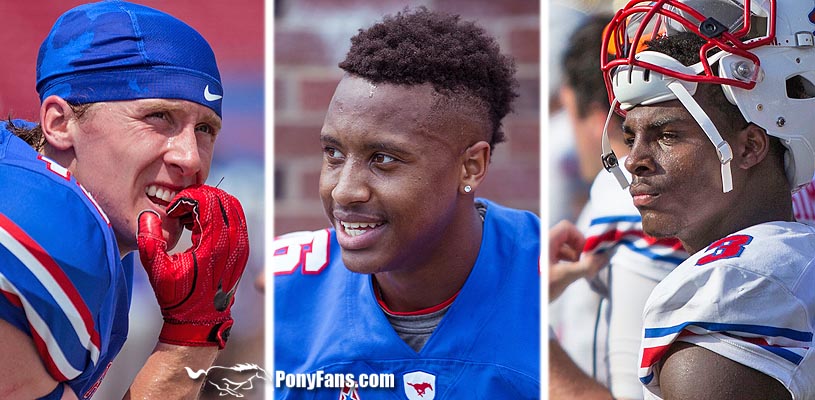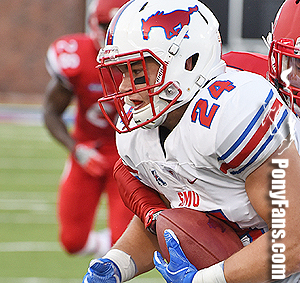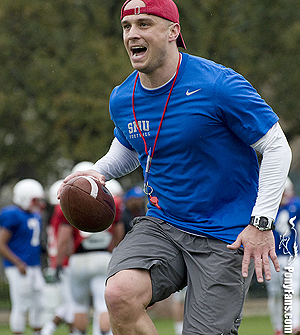 |
| (photo by Photos by Max Franklin / Pat Kleineberg). |
|
There are numerous reasons for the optimism surrounding the 2017 SMU offense. Quarterback Ben Hicks has just about a full year of playing experience as he enters his third season in the Mustangs’ offense, a new physique and increased intensity thanks to the arrival of a pair of talented transfers, Rafe Peavey and D.J. Gillins, who are hoping to force their way into the lineup. The running backs have as much talent and depth as any group since the 1980s. Tackle Chad Pursley is back from an injury that cost him the 2016 season, guard Jerry Saena chose to return after graduating and fielding offers from Power 5 programs and Will Hopkins transferred in from Oregon State, joining center Evan Brown on a line that offensive coordinator Joe Craddock said makes the Mustangs’ coaches feel “blessed.”
To many, however, the strongest position group on the Mustangs’ offense this season might well be the receivers. Whether head coach Chad Morris’ repeated claims that the group is “as good as any in the country” turns out to be accurate can be debated at the end of the season. What is clear, though, is that Hicks and the rest of the Ponies’ passers have an array of targets who can take the pressure off the Mustangs’ running game and should be able to create big plays downfield.
The headliner, of course, is Courtland Sutton, who surprised many when he resisted the urge to declare for the 2017 NFL Draft in order to return for his junior season. Watch any game, and it’s easy to find No. 16. Cornerbacks who get matched up with him get physically dominated. Put a safety or linebacker on him, and Sutton runs past his would-be defender. It didn’t take long last year for teams to start double-teaming him, and until his teammates prove too dangerous to be overlooked, that will continue in 2017.
Pre-draft predictions speculated that had he chosen to go pro, Sutton likely would have been selected in the second round of the 2017 draft, or perhaps even in the latter part of the first, so the list of those who expected him to move on to the next level was long. Craddock, however, insists that he didn’t think Sutton was ready to move on.
 |
| Mitchell Kaufman returns at the position offensive coordinator Joe Craddock says, after the quarterback, "makes the offense go." (photo by Patrick Kleineberg). |
|
“I thought he would come back,” Craddock said. “I thought he trusts us, as coaches, and I think Courtland had a couple of things — just talking to some pro scouts — he had a few things he had to work on. I think that by him coming back, I think he’s a no-doubt first-round guy next year if he’ll continue to develop. That’s one thing Courtland has challenged himself to do: be a great player, not just a good player. He wants that first round, he wants (to be) all-conference, he wants (to be) first-team All-America. He wants all that.
“You see him at practice … he wants to be perfect. He’s striving for perfection. He truly is trying to be the best receiver in the country, whereas this year, there were a bunch of mock drafts where that him four, five, six (among receivers) in the draft, and I think this year he’s a man on a mission to prove to everybody that he’s the best wide receiver in the country. He has got all the physical tools to do that, (but) what I have been most proud of with Courtland this spring is the fact that that he has taken on a leadership role. He has really understood who he is, as a person, and that the younger guys look up to him. He has really helped come on, helped encourage, helped lead — if guys are screwing up, he goes over and gets them right. That’s what I have been most proud of. In spring, he didn’t get a whole lot of reps, because we know what he can do, but as far as mastering his craft, we picked about three things that we thought would really help him at the next level, and he really worked on those things. But again, he strives for perfection. He wants to be the best receiver in the country, hands down, by far, and again, he’s a man on a mission, and I think he’s well on his way to proving that this year.”
Former SMU quarterback Matt Davis used to say that Sutton presented had so many ways of beating defenders that “when I see him in one-on-one coverage, to me, he’s open.” When Davis suffered a season-ending injury in last year’s opener, he was replaced in the lineup by Hicks, who quickly started expressing similar sentiments. There is a reason every coach in the country covets receivers like Sutton: there are few, if any, defensive players who can cover players with his size (6-4, 220), speed and receiving ability. All he did last year was lead the Ponies in every receiving category — 76 receptions, 1,246 yards, 16.39 yards per catch, a long of 88 yards and 10 receiving touchdowns — and there’s no reason to believe he couldn’t or shouldn’t do the same thing in 2017.
But the idea that Sutton is the only target in the passing game would be understandable, but inaccurate. While Morris is generous with his praise for Sutton, he usually defaults to talking about his group of receivers, not just the group’s leader. Sutton might is the headliner, but he will be joined by others who present more-than-credible options for the passing game and will take advantage of defenses who gang up too much on Sutton.
James Proché evolved last year into a dangerous threat, hauling in 57 passes for 709 yards and six touchdowns. Proché is a versatile, smart receiver who can contribute in several ways, in the slot or outside, on deep routes or over the middle. Craddock said Proché and the rest of the receivers benefit from playing with Sutton — not just because of the defensive attention Sutton attracts, but because of the exposure the entire offense could get this season
“I honestly think that James is maturing,” Craddock said. “He’s going from a boy to a man, and to see him develop that way … I’ve been really proud of James (for) just loving the game and coming out every single day and competing and working. When he had to redshirt, and even last year, there were times when he would get in these moods and you just didn’t want be around James, and we have talked about this, and he has just matured so much. Going into his third year, I couldn’t be more proud of James, just his work ethic, him coming to work every day. He sees Courtland, and he knows — all those guys should know — we’re going to have a lot of pro scouts around here this next year — a lot. If they want to play at the next level, those pro scouts aren’t waiting for you to be draft-eligible to see if you’re a guy (worth drafting) or not — they’re making their notes right now.
Based on spring workouts and the early fall practices, the third starting receiver likely will be Trey Quinn, who transferred from LSU and spent the 2016 season working with the Ponies’ scout team. Morris repeatedly has cited Quinn as someone who had an exceptional spring and has stood out early in preseason camp. Craddock said that the team’s new junior receiver has emerged quickly as a leader on the offense without bragging about his time in Baton Rouge.
“He’s a guy that every one of those kids looks up to,” Craddock said of Quinn. “He has played at a high level — he has played in the SEC. He’s a technician. He does everything we ask him to do and more, and he has just got this presence about him — it’s hard to describe. You hear a lot of coaches talk about that ‘it factor’ — Trey has ‘it.’ Whatever ‘it’ is, you get around Trey and see him, how he carries himself, his presence … Trey wants to be great, and there’s no doubt about that. He’s on a mission, as well.
 |
| Receivers coach Justin Stepp gets to work in 2017 with a group of receivers head coach Chad Morris has said is "as good as any in the country." (photo by Patrick Kleineberg). |
|
“We needed Courtland and him to just kind of pick up the pace with leadership. Trey is a guy … he’s not going to say a lot, he’s not going to be a ‘hoo-rah’ guy and hoot and holler, but he’s a leader with his work ethic and how he plays. It has worked out great. He has two years to play, and he’s in the right place — he’s in a system that can showcase his talent. He has been a solid guy that all of those guys like being around.”
One of the themes Morris has reiterated over and over again is that the 2017 season will reveal the Mustangs’ much-improved depth, and that certainly applies to the receivers. If Sutton, Quinn and Proché are, in fact, the starters, the team has enough debth — quality depth — that there won’t be a reason to wear out the starting trio. Shelby Walker is back for his senior season after earning rave reviews from the coaching staff during the spring. Kevin Thomas is another bigger body who Morris has said will shine as soon as his consistency matches his physical tools and skill. Morris also has singled out Myron Gailliard and Alex Honey for having had great camps. Brandon Benson and Joshua Shelmire redshirted last year and appear ready to push for playing time, and true freshmen Judah Bell and Tyler Page already have shown flashes in preseason camp of why Morris and the Mustangs’ coaches raved about them when they signed with SMU in February.
The passing game, and the offense in general, is by no means a finished product. But the assembled talent makes juggling playing time, as Morris likes to say, “a nice problem to have.”
Tight endsWith the possible exception of the offensive line, the tight ends often are the most overlooked group on the offense, as the quarterbacks, receivers and running backs get the lion’s share of the attention on most teams. The coaches insist, however, that dismissing the tight ends as spare parts with this offense would be a mistake. Craddock has gone so far as to say that after the quarterback, the tight ends are the players who really make the SMU offense go.
“They have to be able to block, they have to be able to attach (to the offense) as a true tight end, they have got to be able to receive,” Craddock said. “I don’t think there’s any secret that we want to be able to stay in ’11 personnel’ (one tight end, one running back). We don’t want to have to switch. If you’re going to play fast, you don’t want to take the time to switch, you’ve got to stay in one personnel. These guys have to be able to do a lot of things, and we have a bunch of them who can.”
Tight end is another position where the starter might not be determined until the start of the season, and even then, might change during the season.
One of the candidates is Raymond Epps, who transferred from Arizona State. Epps was limited during spring workouts, but coaches said he picked up the offense quickly and has shown the versatility that is demanded at the position.
“It’s great having Raymond here,” Craddock said. “We hit a home run with him, not from a football standpoint, but from what kind of man he is — he’s an unbelievable character kid. Every one of our kids absolutely loves Ray, but also from the standpoint of … he also played at a high level in the Pac-12. Getting him in here, he kind of had a good familiarity with our offense. They do a lot of things like we do at Arizona State, so he has come in and not missed a beat.”
Regardless of who ends up starting, the Mustangs appear likely to rotate several players at the position, including junior Mitchell Kaufman, sophomores Ryan Becker and Corey Rau, and senior Jordan Severt. Craddock lauded the work done by tight ends coach Keith Gunn to prepare the group, which has included breaking in Epps with the offense and developing a viable receiving threat in Becker, who was projected by some as a future interior offensive lineman when he was recruited.
“I’m really proud of that group,” Craddock said. “I think Coach Gunn has done a great job, bringing them along. I think Coach Gunn deserves a lot of credit for the way Becker has come on. Becker … we have been able to split him out, put him in the backfield. We thought he was going to grow into a tackle, but … the guy can really run, and with Ray in there, helping develop those guys.
“We’ve got some really good tight ends in that room, and I’m really excited about the future with those guys, because I tell them all the time: they are what makes our offense go. When you go out recruiting, and you talk about the most important guy we recruit, it’s the quarterback, (and) the second-most important guy we recruit is the tight end, because that’s what makes this offense go. We have got four to five good ones that are really going to help us out this year, which is really exciting because last year we had Jeremiah (Gaines), who was really a receiver converted into a tight end, and now we feel like we have got three or four or five really good, solid tight ends.”









